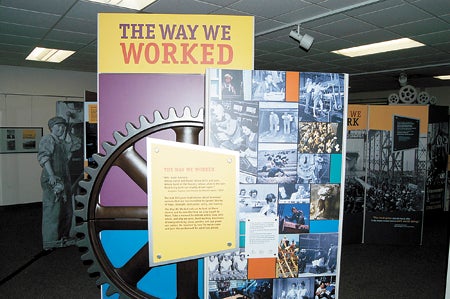‘Work’ at SMC through Dec. 14
“The Way We Worked” is a Smithsonian Institution traveling exhibit at Southwestern Michigan College until Dec. 14.
The exhibit in the Dale A. Lyons building is open 10 a.m. to 5 p.m. Tuesdays through Fridays and draws on the National Archives’ collection of 11 million photos to tell the story of work in American culture, tracing changes affecting the workforce over 150 years, from the elimination of child labor and women entering the job market to the transition from an agrarian America through the industrial revolution to information technology.
Michigan Humanities Council coordinates exhibits as they travel from community to community, from Rogers City in the fall to libraries in Hartland, Escanaba, Clare and Hart after Dowagiac.
“The Way We Worked” is targeted to rural areas and features graphics, audio components, photo flipbooks, film and even work-related hats.
“I thought it was a perfect tie-in with Dowagiac’s history,” Steve Arseneau, director of Dowagiac Area History Museum, said Wednesday.
He applied for the Museum on Main Street grant in 2010.
“Marc Dombrosky of the art gallery described it perfectly,” Arseneau said. “It is an exhibit about the changing nature of work in America over the last 150 years. Themes it looks at are why we work, who works and where we work. It provides a good snapshot of this cultural phenomenon that built America. In other countries, when people meet someone and they ask, ‘What do you do?’ they say they play golf, soccer or something they do for recreation. Americans are defined by work they do.”
A communications case charts the progression from computers, which once filled rooms, to portable pocket computers called phones.
There is a number to dial for additional tour information from the Smithsonian.
Some jobs became extinct — door-to-door milkmen, elevator operators and bowling alley “pin girls.”
Many businesses have come and gone. Anyone remember Dowagiac Auto Top at 101 W. High St.?
“One of my favorite stories,” he said, “is about this Lithuanian immigrant who coalmines in Pennsylvania for three weeks, then moves to Michigan” because he never saw daylight.
One section explores first jobs. Arseneau delivered newspapers and caddied. Most people hold 10 jobs by age 36. Half of baby boomers expect to work after 70.
With 1,200 employees at Round Oak Stove, there were as many people in Dowagiac in 1910 as today.
Local programs with The Way We Worked
• Nov. 15 — “The Women of Heddon,” with Joan Lyons of the Heddon Museum and former employees.
• Nov. 29 — “The Way We Worked” by John Beck, Michigan State University and state historian for the touring exhibit.
• Dec. 5 — “Dowagiac: The Furnace City” by Steve Arseneau, Dowagiac Area History Museum director.
• Dec. 12 — “Beyond a Promise: Working at Studebaker” by Andrew Beckman of Studebaker National Museum.
All programs are free and begin at 6:30 p.m. in the theater of the Dale A. Lyons Building on SMC’s Dowagiac campus.



